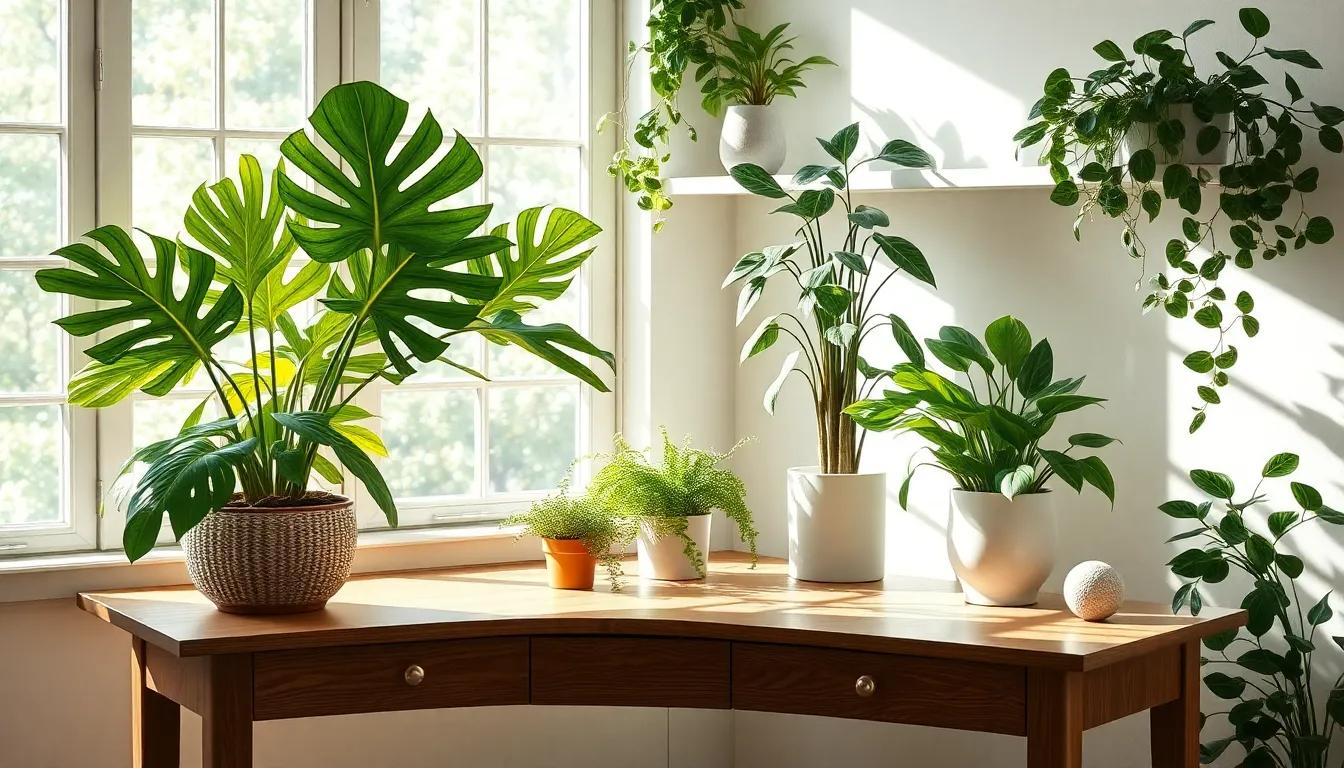In the evolving landscape of home offices, where productivity meets comfort, houseplants have become a cherished companion. They not only enhance aesthetics but also improve air quality, boost mood, and increase focus—a trifecta of benefits that can transform any workspace into a sanctuary of calm and creativity. Whether you’re sowing your first indoor garden or you’re a seasoned plant parent, integrating houseplants into your office is a rewarding endeavor that brings nature’s tranquility indoors.
For those just getting their hands dirty in the realm of indoor gardening, fear not—this journey is as enriching as it is enjoyable. You’ll find that these living companions require only a smidge of attention to thrive, making them the perfect start for newcomers. Meanwhile, experienced gardeners will appreciate the opportunity to expand their collection with houseplants that offer unique shapes, colors, and textures, adding a sophisticated touch to any office nook.
In this article, we will guide you through a selection of ten stunning houseplants, each with its own personality and care requirements. From the resilient yet striking snake plant to the vibrant and playful pothos, you’ll discover plants that suit both your aesthetic preferences and lifestyle. With practical tips and insights, our guide ensures that you’ll find the perfect green companion to not only beautify your office space but also nurture your well-being.
Choosing the Perfect Houseplants
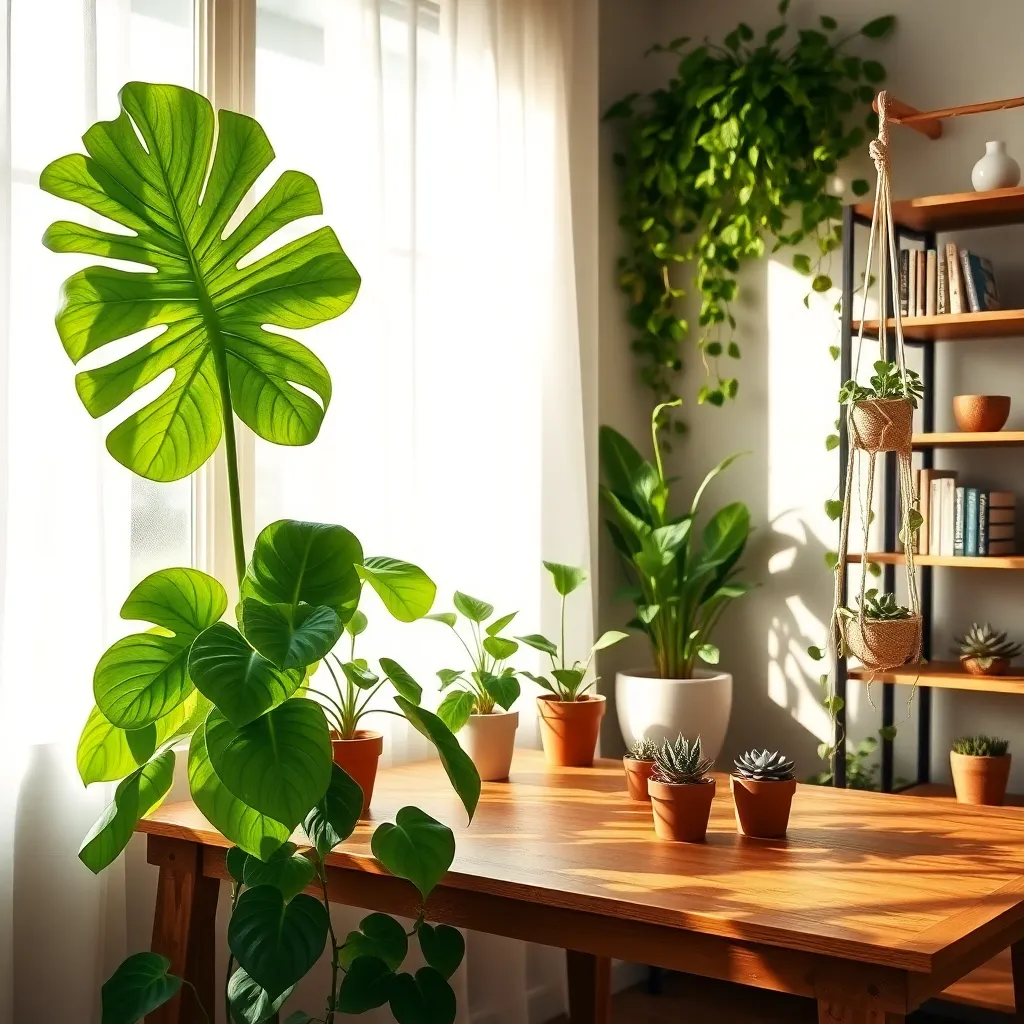
Choosing the perfect houseplant for your home office starts with considering your space and lighting conditions. Bright, indirect light is ideal for many popular office plants, but some can thrive in lower light areas as well.
Before selecting a plant, take into account how much time you can dedicate to its care. Low-maintenance plants like snake plants or pothos are excellent choices for busy professionals.
It’s also important to consider the air quality benefits certain plants can provide. Houseplants like spider plants and peace lilies are known for their air-purifying qualities, making them suitable for creating a healthier office environment.
For those with a little more experience, consider experimenting with humidity levels and soil types to optimize plant health. Use a well-draining soil mix to prevent root rot, and consider a pebble tray to maintain humidity for tropical varieties.
Benefits of Greenery in Workspaces
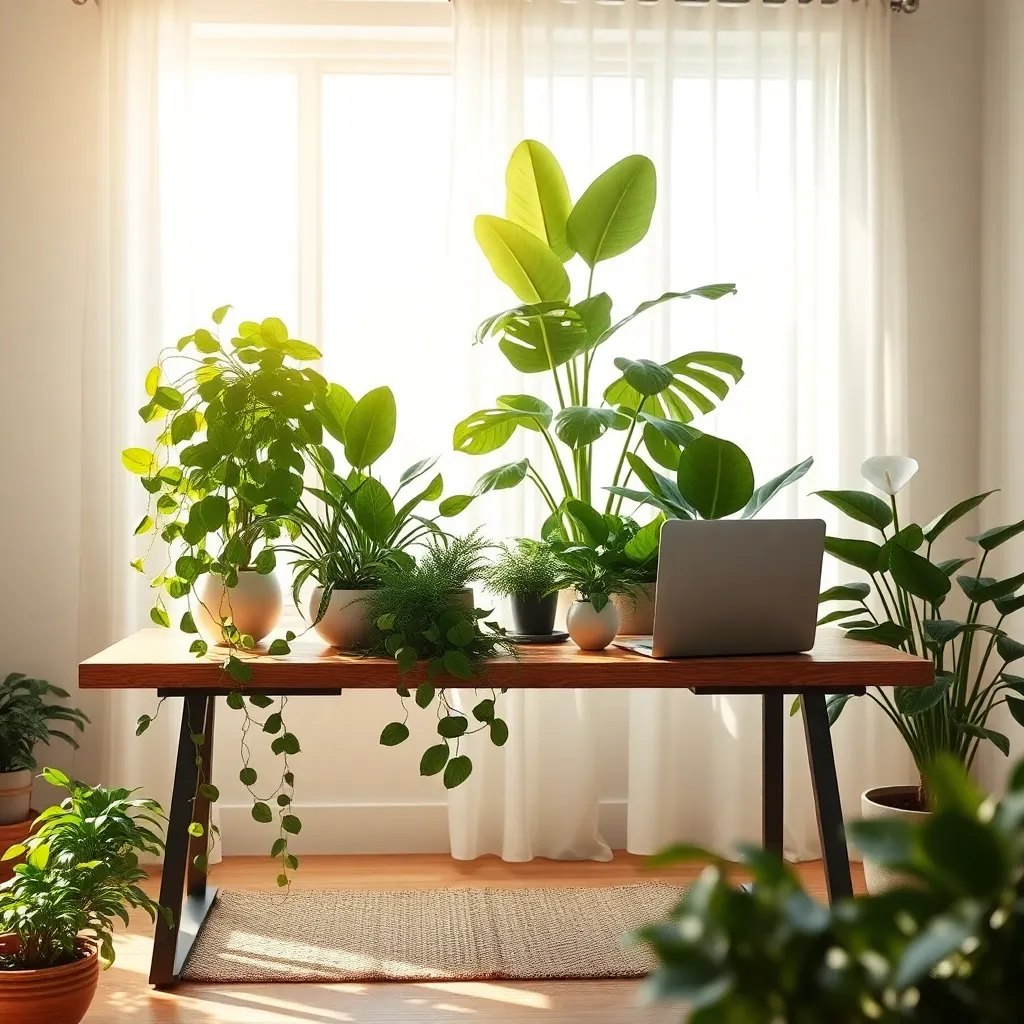
Integrating greenery into workspaces can significantly enhance the overall ambiance and productivity. Studies have shown that having houseplants nearby can reduce stress levels and increase focus, making them a smart addition to any home office.
For beginners, start with hardy plants such as the snake plant or pothos, which are known for their resilience. These plants thrive in low-light conditions and require minimal watering—about once every two weeks—making them ideal for busy professionals.
Advanced gardeners may want to experiment with more demanding species like the fiddle leaf fig, which requires bright, indirect light and consistent moisture without being overwatered. Ensure it is planted in well-draining soil, such as a mix of peat and perlite, to prevent root rot and promote healthy growth.
Incorporating a variety of plants can improve air quality, as they naturally filter toxins and produce oxygen. Consider rotating plants every few months to ensure all receive adequate sunlight and to refresh the visual appeal of your workspace.
Low-Light Plant Options
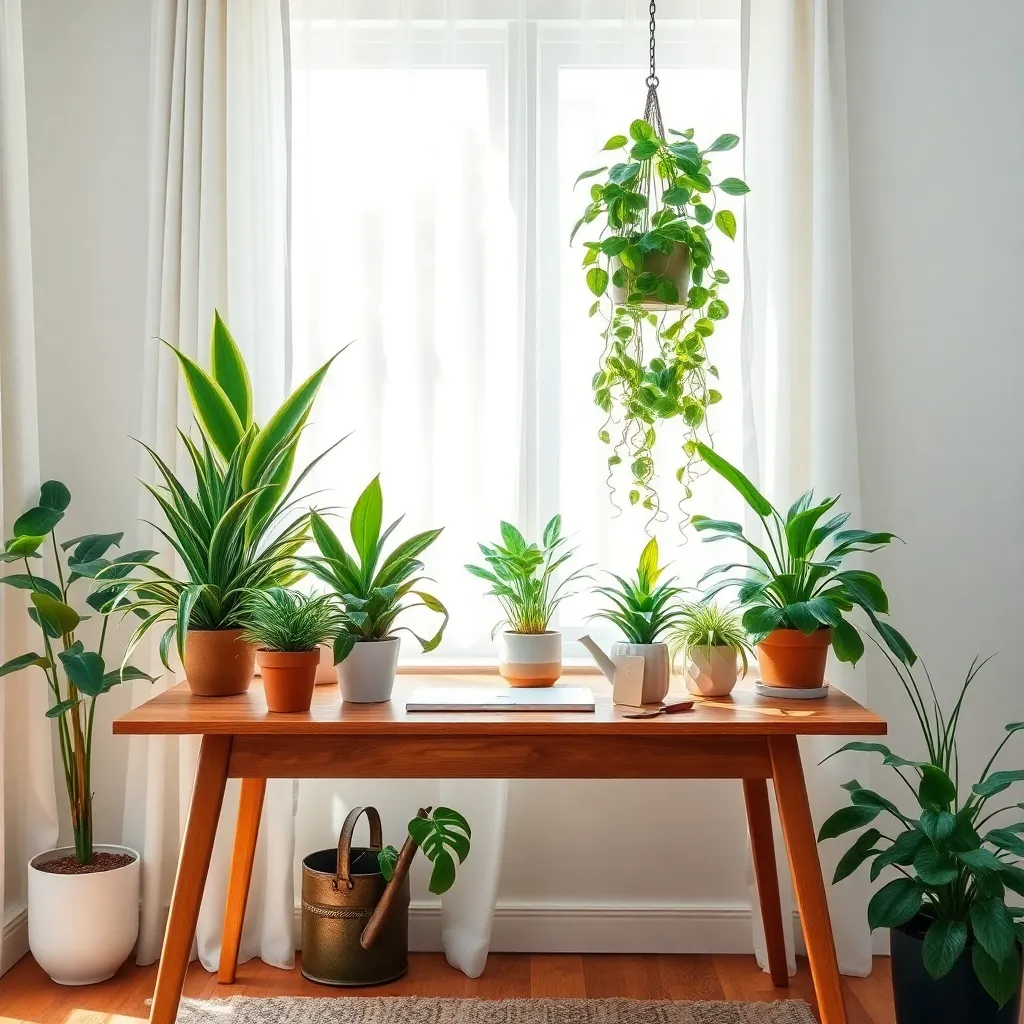
For those with home offices that lack ample sunlight, consider adding low-light houseplants to your space. Snake Plant (Sansevieria) is a resilient choice, thriving in indirect light and requiring watering only when the soil is completely dry.
Another excellent option is the ZZ Plant (Zamioculcas zamiifolia), which can survive in low light and is drought-tolerant. Plant it in well-draining soil, and be cautious not to overwater, as this plant prefers to dry out between waterings.
The Pothos (Epipremnum aureum) is a beginner-friendly plant that adapts well to various lighting conditions, including low light. It’s best to allow the soil to dry out between waterings, which typically means watering every 1-2 weeks.
Advanced gardeners might try the Peace Lily (Spathiphyllum), known for its beautiful white blooms even in low-light environments. Ensure it’s planted in a pot with excellent drainage, and mist the leaves occasionally to maintain humidity levels.
Easy-Care Succulents for Desks

Succulents make perfect desk companions due to their low maintenance and striking appearance. **Aloe Vera**, for instance, only requires watering every two to three weeks, making it ideal for busy professionals.
Consider **Jade Plant** for its attractive, fleshy leaves and easy care routine. This plant thrives in well-draining soil, such as a cactus mix, and needs bright, indirect light to flourish.
**Zebra Haworthia** is another excellent choice, known for its unique striped leaves. It can tolerate low light conditions, although it will grow best in a bright spot with some indirect sunlight.
For those with limited desk space, the **String of Pearls** offers a cascading effect that adds visual interest. This succulent prefers to dry out completely between waterings, so a once-a-month schedule is often sufficient.
Air-Purifying Plant Selections

Transform your home office into a refreshing oasis with plants that purify the air. These air-purifying plants not only enhance the aesthetic appeal of your workspace but also help remove toxins and improve air quality.
The Spider Plant (Chlorophytum comosum) is a superb choice for beginners due to its hardy nature. It thrives in well-draining soil and prefers bright, indirect light, making it ideal for a desk near a window.
Another excellent option is the Snake Plant (Sansevieria), known for its ability to filter formaldehyde and benzene from the air. This plant tolerates low light and infrequent watering, needing water only when the soil is completely dry.
For those looking to add a touch of elegance, consider the Peace Lily (Spathiphyllum). It requires consistent moisture but prefers to dry out slightly between waterings, and does best in medium to low light conditions.
- Tip for Beginners: Start with a Spider Plant for a forgiving introduction to air-purifying plants.
- Advanced Tip: Rotate your Peace Lily weekly to ensure even growth and flowering.
Incorporate these plants into your home office for a healthier and more productive environment. With just a little care, these selections will thrive and provide long-lasting benefits.
Compact Plants for Small Spaces
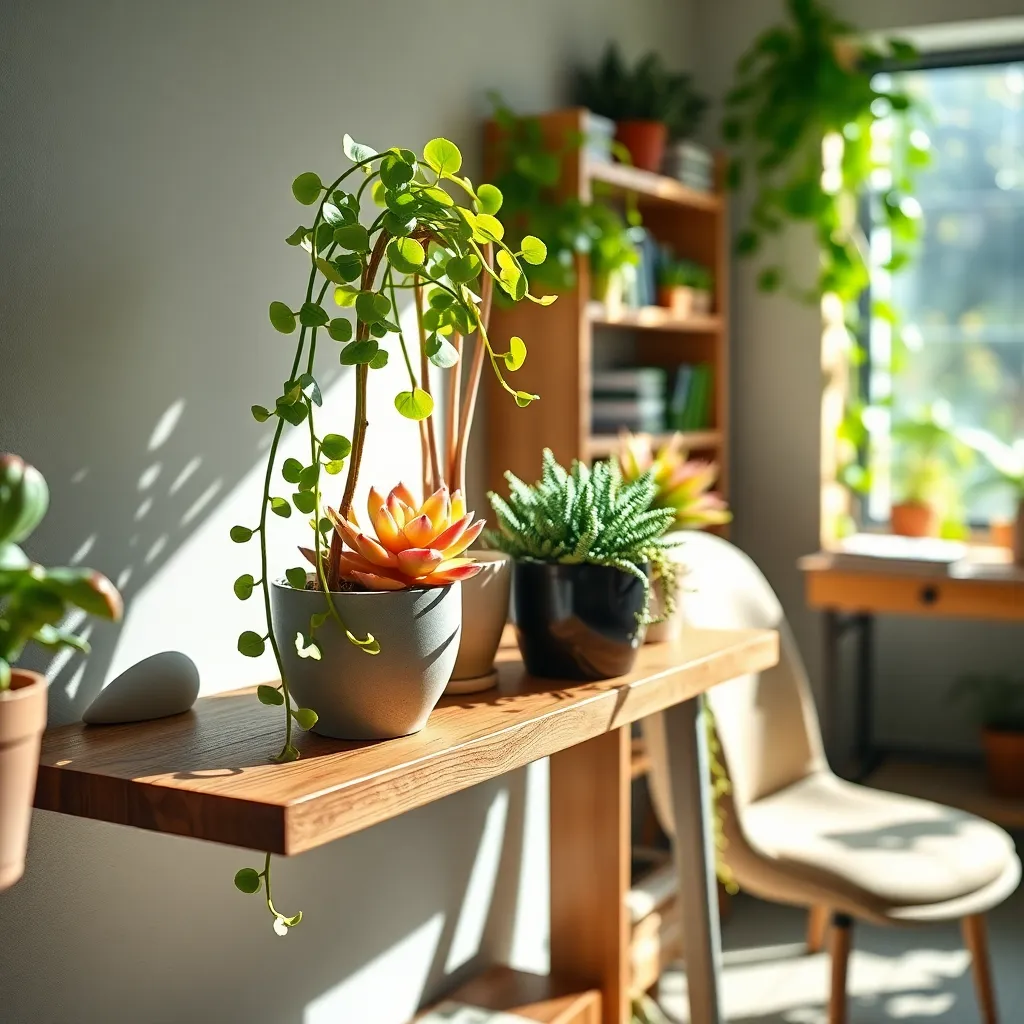
Maximizing the beauty of your home office doesn’t require a lot of space when you choose compact plants. Succulents are an excellent choice for small spaces due to their slow growth and minimal water requirements.
For a vibrant touch, consider the Peperomia species, known for their varied leaf patterns and colors. These plants thrive in well-draining soil, such as a mix of peat and perlite, and prefer bright, indirect light.
Another great option is the Zebra Plant, which adds a striking visual element with its distinctive striped leaves. Water it moderately, ensuring the soil dries out between waterings to prevent root rot.
If you’re seeking a more tropical feel, the Miniature Orchid can be a delightful addition. These orchids need a bark-based potting mix and should be watered weekly, allowing water to drain thoroughly.
For gardeners looking to experiment, try bonsai trees. Though requiring more attention, they offer a rewarding experience; prune regularly and provide consistent moisture, avoiding waterlogged conditions.
Decorative Foliage Varieties
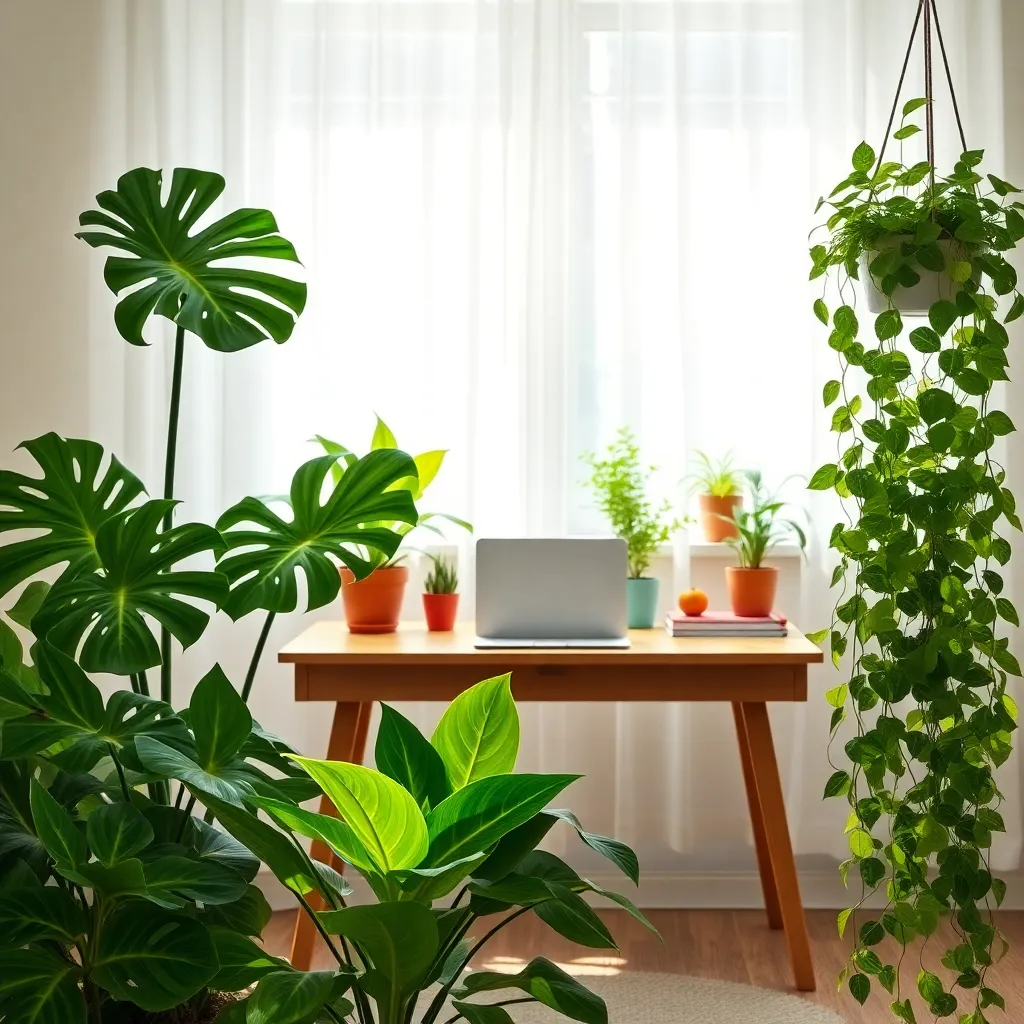
Enhancing your home office with decorative foliage can create a serene and inspiring environment. One beautiful choice is the Calathea, known for its vibrant patterns and lush leaves. To keep your Calathea thriving, place it in a spot with indirect light and ensure the soil remains consistently moist but not waterlogged. Mist its leaves regularly to maintain the high humidity levels it loves, especially in dry indoor climates.
Another excellent option for decorative foliage is the Chinese Evergreen, a plant renowned for its adaptability and striking variegated leaves. It thrives in low to medium light, making it ideal for those tricky office corners. Water the Chinese Evergreen when the top inch of soil feels dry, and use a well-draining potting mix to prevent root rot. For advanced care, fertilize it with a balanced liquid fertilizer every 4-6 weeks during the growing season to promote lush growth.
If you’re looking for something a bit more exotic, consider the Maranta Leuconeura, also known as the Prayer Plant. Its leaves fold up at night, creating a dynamic display of nature’s wonder. Place it in a bright spot without direct sunlight, and use a peat-based soil to mimic its natural habitat. To boost its humidity, consider placing a tray of water nearby or using a pebble tray. For a dramatic touch, group it with other moisture-loving plants to create a mini indoor jungle.
Boosting Productivity with Plants
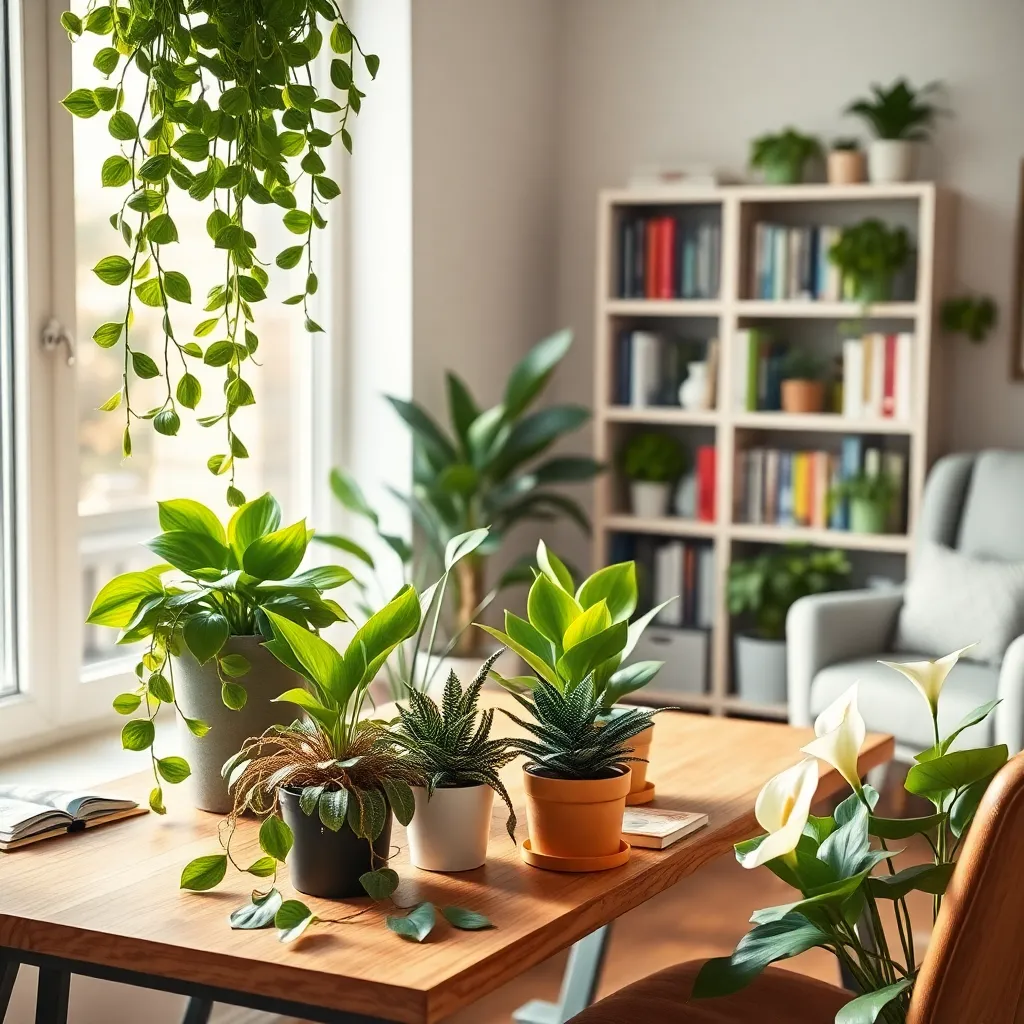
Incorporating houseplants into your home office can significantly boost productivity and enhance well-being. Research has shown that working in environments enriched with plants can increase concentration and reduce stress.
Begin with easy-to-care-for plants like the Snake Plant, which thrives in low light and requires infrequent watering. This resilient plant helps purify the air, providing a cleaner and more oxygen-rich environment that promotes focus.
Another excellent choice for productivity is the Peace Lily, which can thrive in low to moderate light and needs watering once a week. Its lush green leaves add a calming presence to your workspace, while its ability to filter toxins from the air supports a healthier work environment.
For those with a bit more gardening experience, consider the dramatic Fiddle Leaf Fig, which requires bright, indirect light and a well-draining potting mix. Regularly rotate the plant to ensure even growth, and mist its leaves to maintain humidity, fostering a vibrant ambiance that inspires creativity.
To optimize plant care, use a potting mix designed for houseplants and ensure pots have drainage holes to prevent root rot. Consider placing a tray of water near your plants to increase humidity, which is especially beneficial during dry winter months.
Caring for Office Houseplants
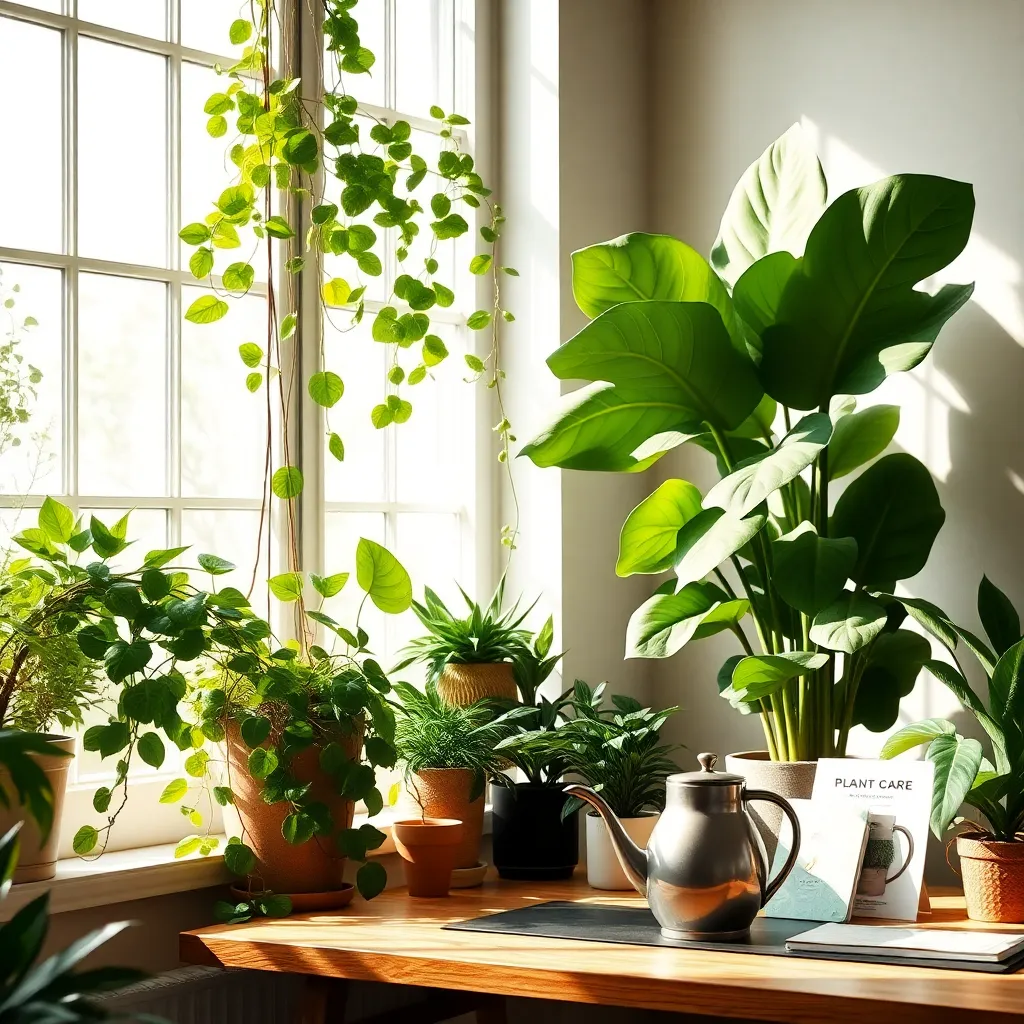
Office houseplants can thrive with just a few simple care routines. Begin by ensuring they are placed in an area with adequate light, as most plants need some form of natural light to grow well.
Consider the specific needs of each plant when deciding on a watering schedule. Generally, checking the soil moisture once a week is a good practice; allow the top inch of soil to dry out before watering again.
For optimal growth, use a well-draining potting mix that suits the plant type. Succulents and cacti prefer a sandy mixture, while tropical plants thrive in a peat-based soil with good aeration.
Humidity is another important factor, especially for tropical plants like ferns and orchids, which prefer higher humidity levels. To increase humidity, place a small humidifier nearby or group plants together.
Fertilizing your office plants every few months can promote healthy growth and vibrant foliage. Use a balanced liquid fertilizer diluted to half strength to avoid overfeeding.
Pruning is essential to maintain plant shape and remove any dead or yellowing leaves. Regularly inspect your plants for pests such as spider mites or aphids, and treat with insecticidal soap if necessary.
For advanced care, consider repotting your plants every year or two to provide fresh soil and additional space for roots. This practice helps prevent root-bound conditions and encourages new growth.
Finally, remember that each plant has unique needs, so observe and adjust your care routine accordingly. With patience and attention, your office houseplants will not only survive but thrive, enhancing your workspace with their natural beauty.
Arranging Plants for Aesthetic Appeal
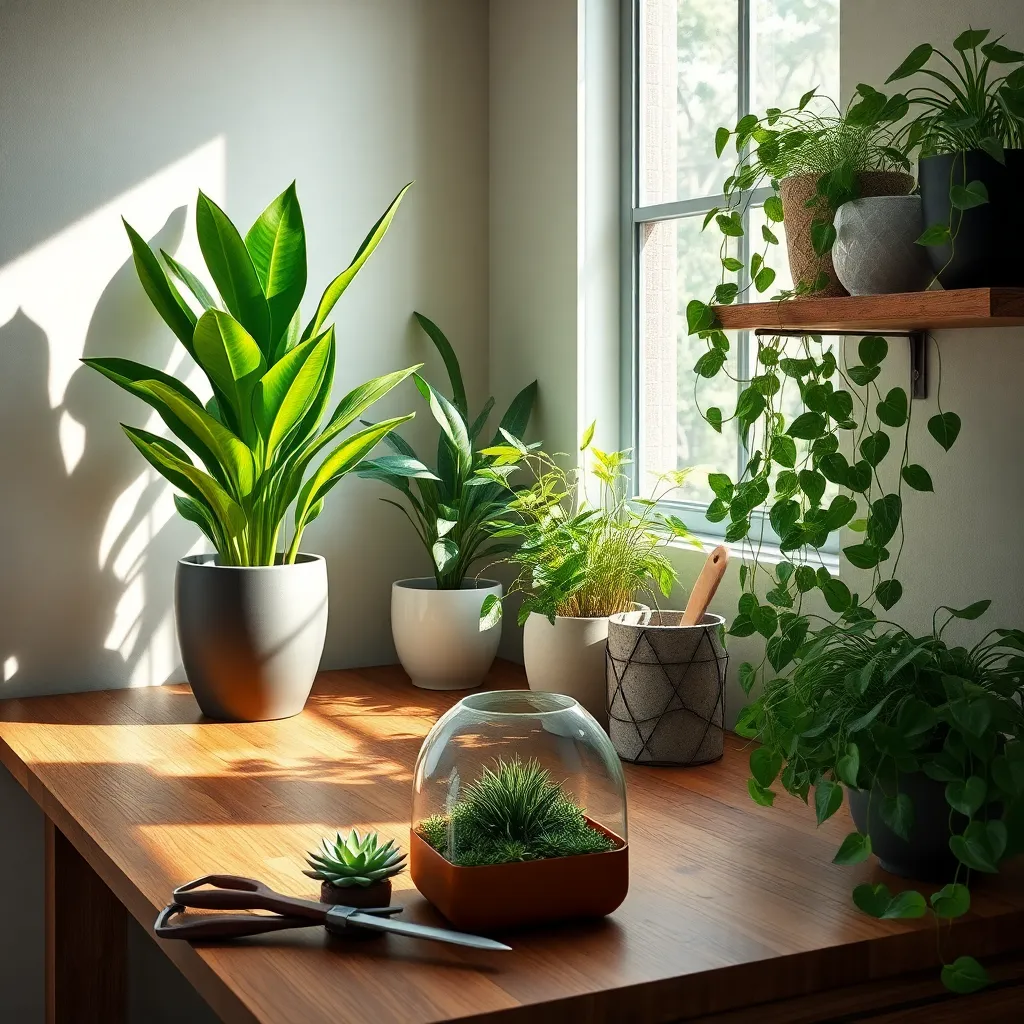
Arranging houseplants in your home office is an art and a science, blending aesthetics with functionality. Begin by selecting a variety of plants with differing heights and textures to create a visually dynamic display.
Position taller plants, such as the majestic fiddle leaf fig or graceful snake plant, towards the back or corners of your space. These plants not only add height but also contribute to a more structured look.
Place medium-sized plants, like the lush pothos or vibrant peace lily, at eye level on shelves or desk corners. This not only breaks up horizontal lines but also draws attention to specific areas of your office.
For a cohesive look, consider grouping plants with similar light and watering needs. This ensures that care routines remain manageable and reduces the risk of neglecting any plant due to differing requirements.
Use small plants, such as succulents or air plants, to fill gaps and add detail to your arrangement. These can be placed on windowsills or in small pots on your desk, offering a touch of greenery without overwhelming the space.
Experiment with different planters and containers, incorporating a mix of colors and materials to enhance the visual appeal. Choose containers with drainage holes to prevent overwatering, ensuring your plants remain healthy and vibrant.
By creatively arranging your houseplants, you can transform your home office into a serene and inspiring environment. With a bit of planning and attention to detail, your plants will thrive, contributing to both the aesthetic and ambiance of your workspace.
Conclusion: Growing Success with These Plants
Incorporating houseplants into your home office not only enhances aesthetic appeal but also nurtures your relationships by fostering a serene and vibrant environment. We’ve explored ten stunning options: the adaptable Snake Plant, the resilient ZZ Plant, the air-purifying Peace Lily, the humidity-loving Boston Fern, the low-maintenance Spider Plant, the elegant Pothos, the brightening Rubber Plant, the calming Lavender, the bold Monstera, and the compact Succulent. Each of these plants contributes to a more harmonious workspace, encouraging productivity and reducing stress, elements crucial for maintaining strong, healthy relationships.
As a next step, choose one plant that resonates with you and incorporate it into your workspace. Notice how the presence of nature can transform your interactions and set a positive tone for your day.
Bookmark this article to revisit these plant options and their benefits, ensuring you have a handy guide as you continue to cultivate both your workspace and your relationships. Remember, nurturing your environment is akin to nurturing your connections—both require attention, care, and a touch of green. By bringing nature into your space, you’re setting the stage for continued relational success and personal growth.

